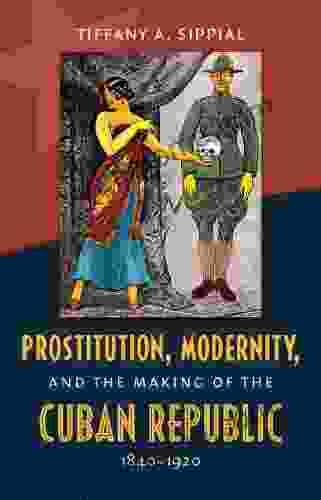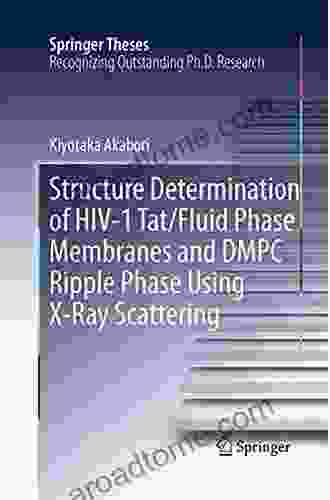Unveiling the Structure of HIV Tat Fluid Phase Membranes and DMPC Ripple Phase: A Journey into the Molecular Architecture of Biological Membranes

4.4 out of 5
| Language | : | English |
| File size | : | 10102 KB |
| Text-to-Speech | : | Enabled |
| Screen Reader | : | Supported |
| Enhanced typesetting | : | Enabled |
| Print length | : | 283 pages |
Biological membranes, the gatekeepers of cells, play a crucial role in maintaining the integrity and functionality of living organisms. Understanding their intricate structure and dynamics is essential for deciphering cellular processes and developing novel therapeutic strategies. This article embarks on an exciting journey into the molecular architecture of biological membranes, shedding light on the groundbreaking structural insights gained through studies on HIV Tat fluid phase membranes and DMPC ripple phase.
HIV Tat Fluid Phase Membranes
The human immunodeficiency virus (HIV) Tat protein plays a pivotal role in viral replication and pathogenesis. Tat interacts with specific lipids in the host cell membrane, inducing the formation of fluid phase membranes—dynamic membrane domains characterized by high fluidity and reduced Free Download. These fluid phase membranes facilitate the entry of HIV into host cells and contribute to the virus's ability to evade the immune system.
Using advanced experimental techniques such as X-ray diffraction and neutron scattering, researchers have uncovered the structural details of HIV Tat fluid phase membranes. These studies revealed that Tat alters the organization of lipids within the membrane, promoting the formation of non-lamellar lipid phases and disrupting the regular packing of lipid molecules. The resulting fluid phase membranes exhibit increased membrane curvature and fluidity, creating a favorable environment for viral entry and replication.
DMPC Ripple Phase
1,2-Dimyristoyl-sn-glycero-3-phosphocholine (DMPC) is a phospholipid that forms a unique ripple phase membrane under specific conditions. Ripple phase membranes are characterized by a periodic, corrugated structure with alternating flat and curved regions. This unusual membrane morphology has attracted considerable interest due to its potential implications in biological systems.
Neutron scattering and molecular dynamics simulations have provided valuable insights into the structure and dynamics of DMPC ripple phase membranes. These studies have shown that the ripple phase is stabilized by specific lipid-lipid interactions and water-lipid interactions. The corrugated structure of the ripple phase membrane creates a highly dynamic environment, with lipid molecules undergoing rapid bending and undulations.
Membrane Interactions and Dynamics
The interactions between lipids and proteins within biological membranes are crucial for membrane function. In the case of HIV Tat fluid phase membranes, Tat directly interacts with specific lipids, altering their packing and dynamics. This interaction leads to the formation of fluid phase membranes, which facilitate viral entry and replication.
In DMPC ripple phase membranes, the unique lipid-lipid and water-lipid interactions give rise to the characteristic ripple phase structure. The dynamic nature of the ripple phase membrane allows for rapid lipid exchange and membrane remodeling, facilitating biological processes such as membrane fusion and fission.
Implications for Biology and Medicine
The structural insights gained from studies on HIV Tat fluid phase membranes and DMPC ripple phase have far-reaching implications for biology and medicine. Understanding the molecular architecture of these membrane systems can shed light on fundamental cellular processes, such as viral entry, membrane trafficking, and signal transduction.
Furthermore, these studies have implications for the development of novel therapeutic strategies. Targeting membrane-specific interactions could provide new avenues for treating viral infections, neurological disFree Downloads, and other diseases associated with membrane dysfunction.
The structural determination of HIV Tat fluid phase membranes and DMPC ripple phase has provided invaluable insights into the molecular architecture of biological membranes. These studies have uncovered the intricate interplay between lipids, proteins, and water molecules that shape the dynamic landscape of membranes. By understanding these structural details, we can gain a deeper appreciation of cellular processes and pave the way for innovative therapeutic approaches. As we continue to explore the captivating world of membrane biophysics, we can unlock the secrets of biological membranes and their profound impact on life itself.
4.4 out of 5
| Language | : | English |
| File size | : | 10102 KB |
| Text-to-Speech | : | Enabled |
| Screen Reader | : | Supported |
| Enhanced typesetting | : | Enabled |
| Print length | : | 283 pages |
Do you want to contribute by writing guest posts on this blog?
Please contact us and send us a resume of previous articles that you have written.
 Book
Book Novel
Novel Page
Page Chapter
Chapter Text
Text Story
Story Genre
Genre Reader
Reader Library
Library Paperback
Paperback E-book
E-book Magazine
Magazine Newspaper
Newspaper Paragraph
Paragraph Sentence
Sentence Bookmark
Bookmark Shelf
Shelf Glossary
Glossary Bibliography
Bibliography Foreword
Foreword Preface
Preface Synopsis
Synopsis Annotation
Annotation Footnote
Footnote Manuscript
Manuscript Scroll
Scroll Codex
Codex Tome
Tome Bestseller
Bestseller Classics
Classics Library card
Library card Narrative
Narrative Biography
Biography Autobiography
Autobiography Memoir
Memoir Reference
Reference Encyclopedia
Encyclopedia Trent Mcconaghy
Trent Mcconaghy Scott Tannenbaum
Scott Tannenbaum Thomas Estabrook
Thomas Estabrook Mark Beckner
Mark Beckner Sara Givens
Sara Givens Sandra L Mollon
Sandra L Mollon Robert Keller
Robert Keller Victoria Allen
Victoria Allen Tina Kent
Tina Kent Sean Michael Davis
Sean Michael Davis Sheri Taylor
Sheri Taylor Monica Leak
Monica Leak Shawn Konecni
Shawn Konecni Robert Fleisher
Robert Fleisher William Richard
William Richard Swami Niranjanananda Saraswati
Swami Niranjanananda Saraswati Paul Neilan
Paul Neilan Ruth Logan Herne
Ruth Logan Herne Viktor P Astakhov
Viktor P Astakhov Tim Timberlake
Tim Timberlake
Light bulbAdvertise smarter! Our strategic ad space ensures maximum exposure. Reserve your spot today!

 Jesus MitchellThe Classic Military History of the Korean War: A Captivating Journey into...
Jesus MitchellThe Classic Military History of the Korean War: A Captivating Journey into... Emanuel BellFollow ·15.7k
Emanuel BellFollow ·15.7k Ivan CoxFollow ·16.4k
Ivan CoxFollow ·16.4k VoltaireFollow ·14.7k
VoltaireFollow ·14.7k Barry BryantFollow ·3.2k
Barry BryantFollow ·3.2k James GrayFollow ·3.1k
James GrayFollow ·3.1k Ernest PowellFollow ·4.3k
Ernest PowellFollow ·4.3k Patrick RothfussFollow ·16.2k
Patrick RothfussFollow ·16.2k Neil ParkerFollow ·4.2k
Neil ParkerFollow ·4.2k

 Timothy Ward
Timothy WardSteamy Reverse Harem with MFM Threesome: Our Fae Queen
By [Author...

 Cody Blair
Cody BlairThe Ultimate Guide to Energetic Materials: Detonation and...
Energetic materials are a fascinating and...

 Kenzaburō Ōe
Kenzaburō ŌeProstitution, Modernity, and the Making of the Cuban...
By Emily A....

 Kirk Hayes
Kirk HayesUnveil the Enchanting World of The Rape of the Lock by...
Alexander Pope's epic...

 Ivan Turgenev
Ivan TurgenevTantric Quest: An Encounter With Absolute Love
Embark on a Tantric Quest to...

 Gary Reed
Gary ReedThe Darwin Awards: Evolution in Action
The Darwin Awards are a...
4.4 out of 5
| Language | : | English |
| File size | : | 10102 KB |
| Text-to-Speech | : | Enabled |
| Screen Reader | : | Supported |
| Enhanced typesetting | : | Enabled |
| Print length | : | 283 pages |










